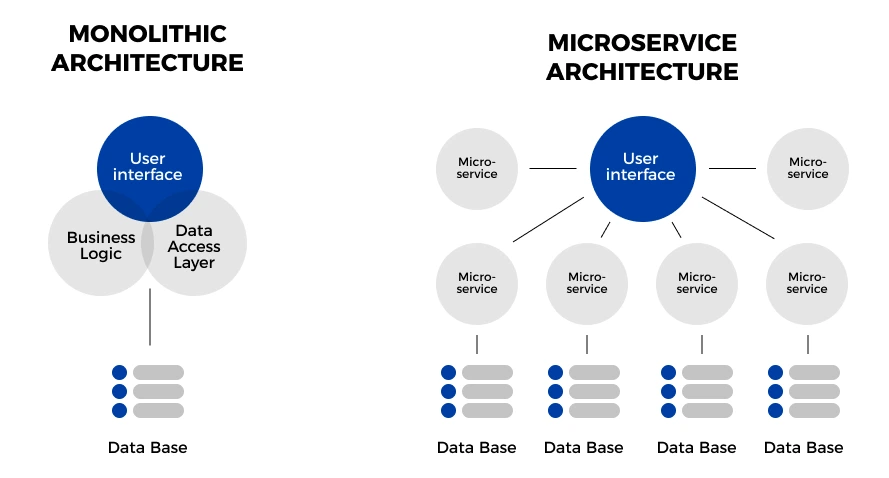maintainability. Two popular architectural styles are monolithic systems and microservices architecture. Both approaches serve different needs but share a common foundation: API integration.
This article breaks down the concepts of monoliths and microservices, compares their benefits and drawbacks, and explains how APIs enable communication in each. Whether you’re a developer, architect, or manager, this guide will help you decide which architecture fits your project requirements while following software development best practices.
What Is a Monolithic Architecture?
A monolithic architecture refers to building an application as one unified codebase where all the functionalities—such as UI, business logic, and data handling—are tightly integrated and run as a single service.
Advantages of Monolithic Systems
- Simplicity in development: Easier to build and deploy initially due to its unified nature.
- Fast internal communication: Modules interact within the same process, reducing latency.
- Centralized debugging: Tracking down issues is straightforward because everything is contained in one place.
Disadvantages of Monolithic Systems
- Scalability challenges: Scaling means replicating the entire application, even if only one feature needs more resources.
- Tightly coupled components: Changes in one part can unintentionally affect others, making maintenance harder.
- Risky deployments: A small update requires redeploying the whole system, increasing potential downtime.
For example, LinkedIn initially developed its platform as a monolith but gradually transitioned to microservices as it expanded to better handle scalability needs.
What Is Microservices Architecture?
Microservices architecture divides an application into smaller, independent services that focus on specific business tasks. These services communicate with one another through APIs, commonly using REST or gRPC protocols.
Advantages of Microservices
- Independent scalability: Each service can be scaled according to its own demand.
- Technological diversity: Teams can use different programming languages or frameworks for different services.
- Faster deployments: Smaller codebases enable quicker and safer updates.
- Improved fault tolerance: A failure in one service doesn’t bring down the entire system.
Disadvantages of Microservices
- Complexity management: Handling multiple services requires robust tools for orchestration and monitoring.
- Increased operational overhead: Managing many deployment pipelines and services adds complexity.
- Data consistency concerns: Coordinating data across services can be challenging.
Netflix is a well-known example of an organization that successfully adopted microservices to handle a huge user base with high availability.
The Importance of APIs in Both Architectures
Whether you’re working with monolithic or microservices-based systems, APIs play a vital role in how components communicate and share data.
APIs in Monolithic Applications
Within a monolith, different modules often interact through internal APIs or direct method calls inside the same application process. Additionally, external APIs may be used to connect to third-party services such as payment gateways or email platforms.
For instance, an e-commerce monolith might have a checkout module that directly calls the inventory and user account modules via internal functions.
APIs in Microservices Architecture
In microservices, APIs form the core communication method. Services expose well-defined APIs that other services consume, often over HTTP or gRPC protocols. This decouples services, allowing them to run and be maintained independently.
For example, in a microservices-based e-commerce system, the shopping cart service interacts with the inventory service using HTTP APIs. This separation lets each service evolve without affecting the others.
Key Differences Between Monoliths and Microservices
- Deployment: Monoliths deploy as a single package; microservices deploy as independent services.
- Scalability: Monoliths require scaling the entire application; microservices allow scaling individual components.
- Development speed: Monoliths enable faster initial development; microservices support faster iterations over time.
- API usage: Monoliths rely on internal calls; microservices depend heavily on API communication.
- Fault tolerance: Monoliths have limited fault isolation; microservices improve resilience.
- Technology stacks: Monoliths typically use a single stack; microservices allow multiple stacks.
Choosing the Right Architecture for Your Project
The decision depends on your application’s scale, complexity, and team.
Consider monolithic architecture if:
- You are creating a minimum viable product (MVP) or a relatively simple app.
- Your team is small and focused on rapid development.
- You don’t need extensive scaling or distributed teams.
Consider microservices architecture if:
- You are building a large, complex, or cloud-native application.
- Your development teams are large and possibly distributed.
- You require independent deployments and granular scaling.
Best Practices for API Integration and Software Architecture
Regardless of your choice, the success of your architecture depends on strong API design and management. Some best practices include:
- Designing clear, consistent, and versioned APIs.
- Documenting APIs thoroughly using standards such as OpenAPI or Swagger.
- Securing APIs with authentication, authorization, and rate limiting.
- Monitoring APIs actively to detect and resolve issues promptly.
Conclusion
Understanding the role of APIs in monolithic systems and microservices architecture is essential in today’s software landscape. While monoliths offer simplicity and speed for small to medium applications, microservices provide scalability and flexibility for larger, more complex projects. APIs act as the essential communication layer in both, enabling modular, maintainable, and scalable applications.
By carefully assessing your project needs and applying robust API integration strategies, you can select the architecture that best fits your software development goals and ensures long-term success.




